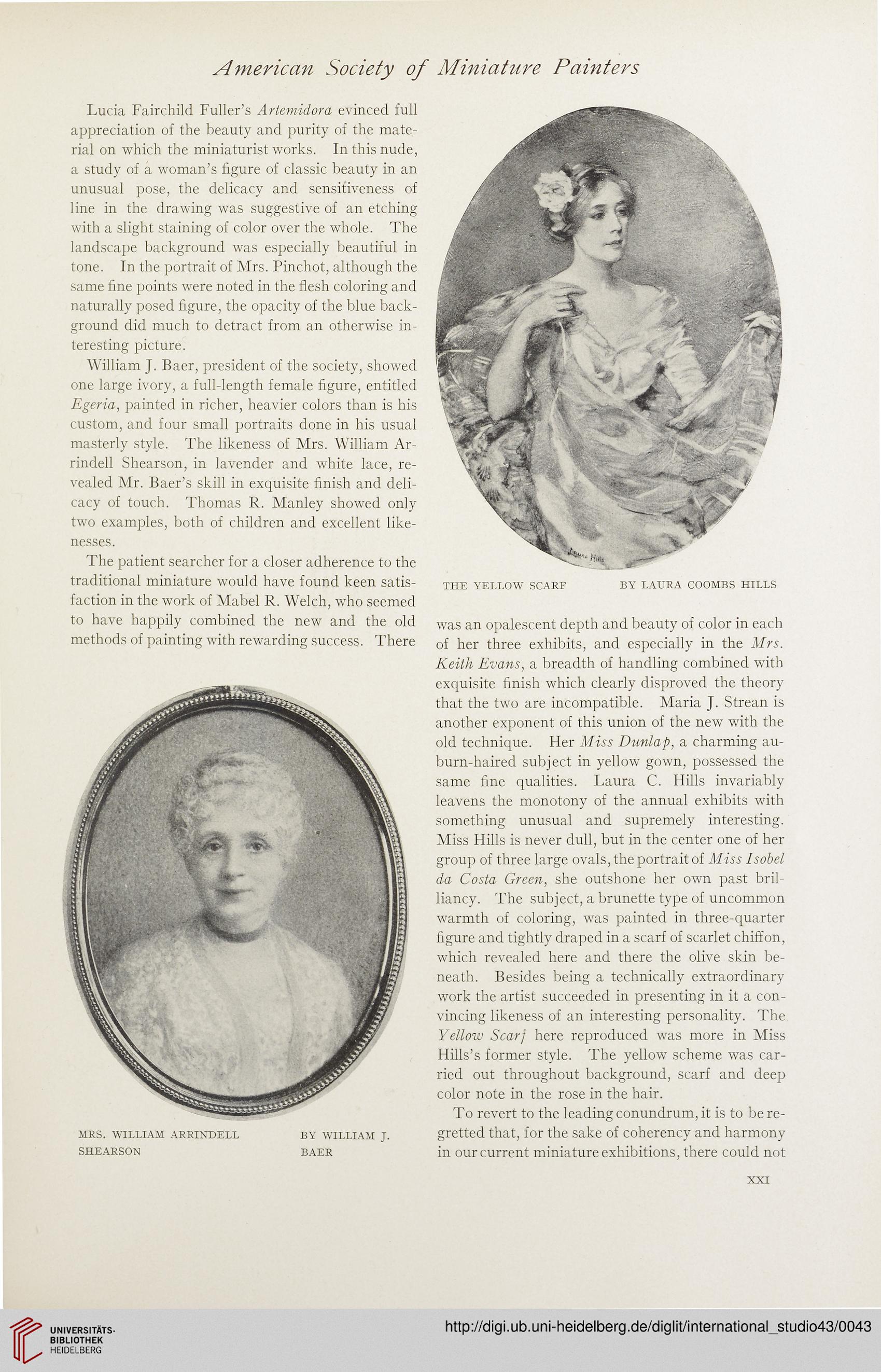American Society of Miniature Painters
Lucia Fairchild Fuller’s Artemidora evinced full
appreciation of the beauty and purity of the mate-
rial on which the miniaturist works. In this nude,
a study of a woman’s figure of classic beauty in an
unusual pose, the delicacy and sensitiveness of
line in the drawing was suggestive of an etching
with a slight staining of color over the whole. The
landscape background was especially beautiful in
tone. In the portrait of Mrs. Pinchot, although the
same fine points were noted in the flesh coloring and
naturally posed figure, the opacity of the blue back-
ground did much to detract from an otherwise in-
teresting picture.
William J. Baer, president of the society, showed
one large ivory, a full-length female figure, entitled
Egeria, painted in richer, heavier colors than is his
custom, and four small portraits done in his usual
masterly style. The likeness of Mrs. William Ar-
rindell Shearson, in lavender and white lace, re-
vealed Mr. Baer’s skill in exquisite finish and deli-
cacy of touch. Thomas R. Manley showed only
two examples, both of children and excellent like-
nesses.
The patient searcher for a closer adherence to the
traditional miniature would have found keen satis-
faction in the work of Mabel R. Welch, who seemed
to have happily combined the new and the old
methods of painting with rewarding success. There
MRS. WILLIAM ARRINDELL
SHEARSON
BY WILLIAM J.
BAER
THE YELLOW SCARF
BY LAURA COOMBS HILLS
was an opalescent depth and beauty of color in each
of her three exhibits, and especially in the Mrs.
Keith Evans, a breadth of handling combined with
exquisite finish which clearly disproved the theory
that the two are incompatible. Maria J. Strean is
another exponent of this union of the new with the
old technique. Her Miss Dunlap, a charming au-
burn-haired subject in yellow gown, possessed the
same fine qualities. Laura C. Hills invariably
leavens the monotony of the annual exhibits with
something unusual and supremely interesting.
Miss Hills is never dull, but in the center one of her
group of three large ovals, the portrait of Miss Isohel
da Costa Green, she outshone her own past bril-
liancy. The subject, a brunette type of uncommon
warmth of coloring, was painted in three-quarter
figure and tightly draped in a scarf of scarlet chiffon,
which revealed here and there the olive skin be-
neath. Besides being a technically extraordinary
work the artist succeeded in presenting in it a con-
vincing likeness of an interesting personality. The
Yellow Scarj here reproduced was more in Miss
Hills’s former style. The yellow scheme was car-
ried out throughout background, scarf and deep
color note in the rose in the hair.
To revert to the leading conundrum, it is to be re-
gretted that, for the sake of coherency and harmony
in our current miniature exhibitions, there could not
XXI
Lucia Fairchild Fuller’s Artemidora evinced full
appreciation of the beauty and purity of the mate-
rial on which the miniaturist works. In this nude,
a study of a woman’s figure of classic beauty in an
unusual pose, the delicacy and sensitiveness of
line in the drawing was suggestive of an etching
with a slight staining of color over the whole. The
landscape background was especially beautiful in
tone. In the portrait of Mrs. Pinchot, although the
same fine points were noted in the flesh coloring and
naturally posed figure, the opacity of the blue back-
ground did much to detract from an otherwise in-
teresting picture.
William J. Baer, president of the society, showed
one large ivory, a full-length female figure, entitled
Egeria, painted in richer, heavier colors than is his
custom, and four small portraits done in his usual
masterly style. The likeness of Mrs. William Ar-
rindell Shearson, in lavender and white lace, re-
vealed Mr. Baer’s skill in exquisite finish and deli-
cacy of touch. Thomas R. Manley showed only
two examples, both of children and excellent like-
nesses.
The patient searcher for a closer adherence to the
traditional miniature would have found keen satis-
faction in the work of Mabel R. Welch, who seemed
to have happily combined the new and the old
methods of painting with rewarding success. There
MRS. WILLIAM ARRINDELL
SHEARSON
BY WILLIAM J.
BAER
THE YELLOW SCARF
BY LAURA COOMBS HILLS
was an opalescent depth and beauty of color in each
of her three exhibits, and especially in the Mrs.
Keith Evans, a breadth of handling combined with
exquisite finish which clearly disproved the theory
that the two are incompatible. Maria J. Strean is
another exponent of this union of the new with the
old technique. Her Miss Dunlap, a charming au-
burn-haired subject in yellow gown, possessed the
same fine qualities. Laura C. Hills invariably
leavens the monotony of the annual exhibits with
something unusual and supremely interesting.
Miss Hills is never dull, but in the center one of her
group of three large ovals, the portrait of Miss Isohel
da Costa Green, she outshone her own past bril-
liancy. The subject, a brunette type of uncommon
warmth of coloring, was painted in three-quarter
figure and tightly draped in a scarf of scarlet chiffon,
which revealed here and there the olive skin be-
neath. Besides being a technically extraordinary
work the artist succeeded in presenting in it a con-
vincing likeness of an interesting personality. The
Yellow Scarj here reproduced was more in Miss
Hills’s former style. The yellow scheme was car-
ried out throughout background, scarf and deep
color note in the rose in the hair.
To revert to the leading conundrum, it is to be re-
gretted that, for the sake of coherency and harmony
in our current miniature exhibitions, there could not
XXI




